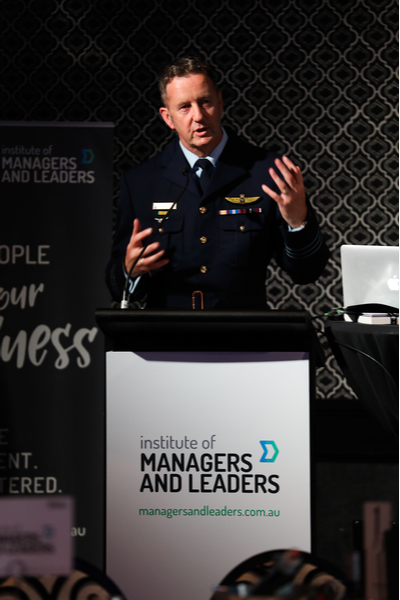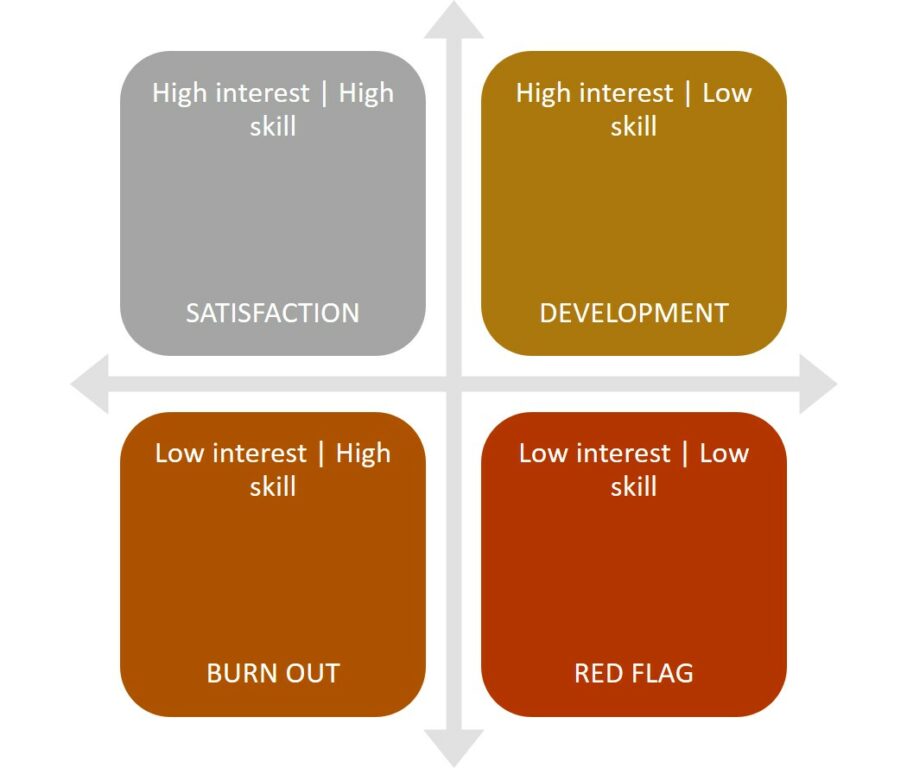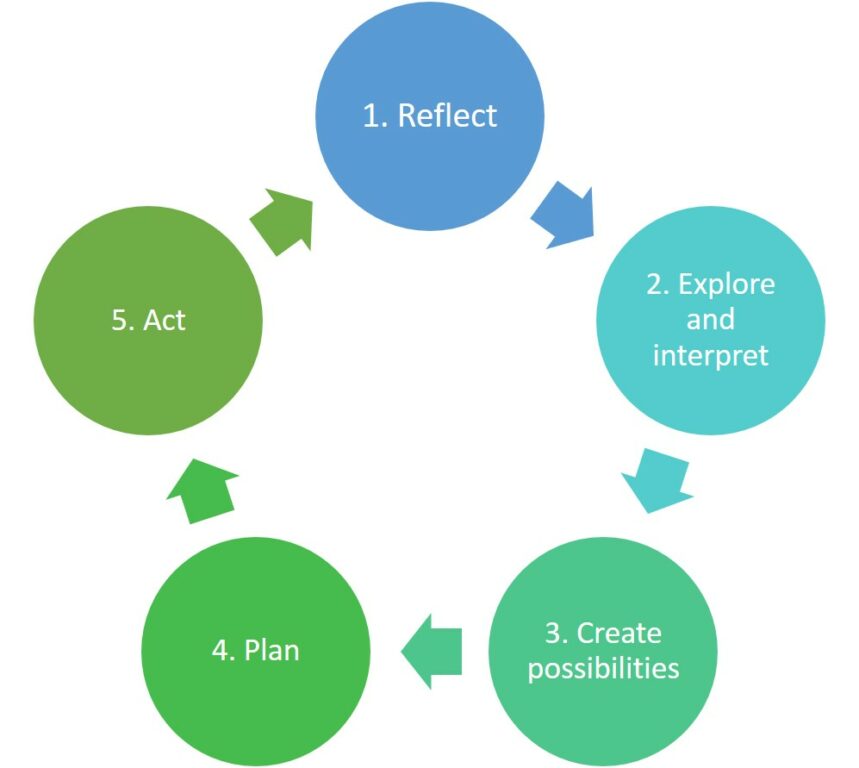Sometimes a simple helping hand can make a truly lasting impact on someone’s future. For Bianca Thatcher, a Bachelor of Business student at The Griffith Business School, a helping hand came in the form of the Eka Suputra IML Scholarship.
Continue readingFive ways leaders can overcome a lack of confidence
Ever wonder what the secret to feeling confident is? It turns out there are a combination of components that lead to feeling positive about yourself.
Continue readingClosing the student employability gap
Every student’s goal when completing higher education is to increase their employability. But the reality for many is that the highly competitive job market puts students at a disadvantage. Find out why this is the case and what can be done to close the employability gap.
Continue readingAccreditation: The secret to a successful transition
Humans are hardwired to resist uncertainty. It’s no wonder change can be daunting even for some of the most resilient people – those in the defence force.

In 2018, the Department of Defence released the Transition Taskforce report, that estimates around 5,500 to 6,000 members of the defence force leave active service annually. That means thousands of men and women make a life-changing transition every year.
The same report reveals that a significant barrier to an effective transition is feeling unprepared, or ill-equipped to manage the differences between the military and civilian environments.
It’s a common feeling. “There’s always that fear, I know I felt it when I made the change when I left the Royal Air Force,” recalls Paul Hughes CMgr FIML, former Officer Commanding 3 Wing Australian Air Force Cadets and now a client relationship manager for Converge International, one of the largest employee assistance providers in Australia.
“I think it’s because it’s perceived as two different worlds, the military and the ‘civvy’ (civilian) world. But they’re more similar than what people imagine.”
Minding the gap
And where there are differences in these two worlds, it seems veterans simply need to validate the skills they already gained in service.
That’s what Ben Urquhart CMgr AFIML, a communications electronic technician for the RAAF who later secured leadership roles at Saab Australia, Ultra Electronics and Kongsberg Defence Australia, discovered.

“One of the challenges coming out of service was that I didn’t know how to talk to civilians,” says Urquhart. Not that he lacked communication skills, but he had to adjust his style to suit a new audience – one that didn’t have the military mindset. Urquhart points out that it was “the communication skills to motivate people,” that he crucially needed.
Urquhart looked towards leadership skills development to close that gap and completed a diploma course. However, he reached a stage in his career where classes just weren’t enough. “I considered doing an engineering degree but quickly realised that I wanted to stand out for my management and leadership skills, not my technical skills,” says Urquhart. So Urquhart applied to become a Chartered Manager, the highest accreditation available for managers and leaders.
Hughes believes this is a vital step for those wanting to validate their skills as they exit the defence force. “Accrediting your skills is a key move. It’s about realising your worth and value, knowing what you can bring to the table and getting formal recognition for it,” says Hughes.
Three tips on making a successful transition
Both Urquhart and Hughes believe that there are many practical steps to take if you want to make a successful career transition into the civilian workplace.
- Network with non-military professionals. Urquhart has thoroughly enjoyed networking with leaders from different industries as a member of the Institute of Managers and Leaders Australia and New Zealand (IML ANZ). It has opened his mind to the way others have achieved success. Plus, the Transition Taskforce report lists establishing new networks as one of the ways to enable a successful transition into civilian life.
- Accredit your skills. Neither Hughes nor Urquhart completed a degree, but that didn’t stop them from becoming successful and respected leaders. Hughes believes that by obtaining a designation, such as Chartered Manager, you gain clarity on your professional ‘mission’. It helps you become a leader who continually develops their knowledge and competence while empowering you to make a positive impact on others.
- Build up your courage. Hughes observes that the military provides its people with excellent leadership skills training. So veterans often enter the non-military world already equipped with sought-after leadership skills. Formal recognition of those skills can give you the courage you need to back yourself. Remember, to foil fear you need courage.
The business world needs better leaders
Find out how you can accredit your leadership skills and gain confidence and courage. Take the Chartered Manager eligibility quiz now.
Work-ready: How to build your LinkedIn profile
More than 100 million job applications are made via LinkedIn each month. So, you need to do everything you can to build a strong profile. Here’s how.
Continue readingSeth Godin: 12 tips on leadership, business and marketing
His name is Seth, he’s been dubbed the King of Marketing by Forbes, and he cooks for his family every night.
He is Seth Godin, author of 19 bestsellers, including Linchpin, Permission Marketing and Purple Cow.
His daily blog has a readership in the millions.
Ahead of his virtual workshop in May 2020, the Marketing Hall of Fame inductee spoke with IML ANZ partner, The Growth Faculty. Godin shared lessons from his latest book, the #1 Wall Street Journal Bestseller and instant New York Times bestseller This is Marketing, and some fascinating personal tidbits about himself.
Empathy is all that is available to us (marketers) if we seek to change someone else. They don’t see what we see, or know what we know. We need to earn enrolment “I’m going over there, do you want to come?”
Begin with a hurdle you can leap. You have no chance of changing everyone. Begin with the smallest viable market. Understand their worldview. Use psychographics, what they believe in, not demographics.
Your followers will tell others. If the small group that you seek to serve believes in you, and trusts you, then they will tell the others (if it raises their status to tell others about you).
There is no impact unless you change someone. A lot of people in marketing say that they do their job, and run ads. I ask them, ‘What change are you seeking to make?’. ‘Oh, I’m not changing anyone,’ they say. So, I ask, ‘Then, why are you wasting my time?’. No change, no marketing.
You can’t be seen until you learn to see. Do your customers feel you see them? Every brand, every marketer makes hard decisions all the time. Are you erring on the side of looking at your banker, or looking at your customer?
Authenticity is nonsense. An authentically bad surfboard? That’s not what I want. I want consistency. I want professionalism. Add that to empathy, and you get a promise of x, y, and z. I see your fears and desires.
The marketer is the CEO, the head of customer service, she’s the supply chain. If you’re interacting with me, you are marketing. Marketing is more about doing and action, now more than ever people are buying on reputation and proof.
A brand is not a logo. Think about a logo you admire, it will be a brand you admire. A logo is a symbol. A brand is a promise. If Nike opened a hotel, you would know what it looked like, if Hyatt had a brand of sneaker you would have no idea what it would be like. Hyatt has a logo, not a brand.
Direct marketing should be measured. Conversely, brand marketing is spending the money on the prayer, the hope, the belief, that it will change someone over time. If you spend money on FB for branding, stop the measuring, don’t measure the clicks.
In every (Adwords) auction that is taking place, Google keeps 95% of the money. You do the work, take the risk, yet Google makes the bulk of the money. You need to do something unique and different, so people search for you by name.
Status is super important. If you’re a hairdresser, you’re not selling a haircut, you’re selling an improvement in a person’s status. Marketers need to be asking ‘Am I raising the status, keeping it the same, lowering it?’
Daily practises for marketers should include strategic thought. How are you serving them, how are you earning their trust? Writing a blog every day for 17 years earns people trust. Your daily practise might be making 5 phone calls today to your best customers saying ‘How’s it going, are you in a jam, how can I help?’
Secure your place for The leadership Circle with Seth Godin
IML ANZ is delighted to partner with The Growth Faculty to bring you The Leadership Circle with Seth Godin.
This is a rare opportunity for leaders and their teams to learn from this best-selling author and leadership titan. Our IML ANZ community enjoy an exclusive discount to Seth’s 3.5 hour interactive virtual workshop.
Save 40% on tickets when you book here.
A Chartered Manager strengthens his commitment to the leadership profession
We recently sat down with Gareth Sipple-Asher CMgr MIML to chat about what it means to become a Chartered Manager. Sipple-Asher received the designation through IML ANZ’s Pathway Partnership with Griffith University. In this interview, he reflects on his journey, shares lessons learned and provides advice for others on the pathway to becoming Chartered.
What did you learn throughout the process of becoming a Chartered Manager?
The key learning for me is the significance of our commitment to the profession of leadership. Our conduct and the way we treat people, be they colleagues or those under our care, demonstrates our level of commitment to the wider community. If our ethical values hold no substance and we choose to flaunt them as a way of building superficial trust or recognition, then our core values are built on a lie that will eventually be discovered. If we build our values around an agreed code of conduct, as leaders, we instil a sense of personal responsibility and accountability across our community and with it a strong sense of cultural awareness.

How has the process of becoming Chartered benefited you?
The process helped me to understand the value of committing to the CPD. We often have good intentions when considering our personal development. Unfortunately, the responsibilities we have outside of our personal growth give us an excuse to keep putting it off. I have realised a vast resource that offers an abundance of knowledge at my fingertips. All that is required is a personal commitment to continued learning as a perpetual student of leadership.
How valuable was it for Griffith to offer Chartered Manager as part of their MBA program?
I strongly believe the offer to become a Chartered Manager through Griffith provides the vital link that seeks to align hard and soft leadership skills. Becoming Chartered for me is not a badge or a membership, it’s a commitment to uphold a code of conduct that underpins sustainable leadership. Griffith University actively promotes the commercial value behind environmental sustainability. By offering MBA students the chance to become Chartered, Griffith University is also promoting the commercial advantage of sustainable leadership.
What tips would you give to others who are completing their Chartered Manager Assessment?
The opportunity to become Chartered does not only apply to individuals in leadership roles. Positive cultural change can take many forms. Effective leadership relies on the conversion of early adopters to take up a cause and build its value from within. Chartered Managers who form part of the stakeholder community and live the values through their commitment to the charter are as valuable to the organisation as the leaders above them.
Having the confidence and resolve to call out toxic leadership or unethical behaviour is the ultimate way to manage up and ensure those in charge are held accountable to the values of the organisation. Becoming Chartered will not only help you as a leader, but it will also offer a distinct advantage to your capability as a professional.
Get on the pathway to better leadership
If you’d like to find out more about how IML ANZ can support you to include the internationally recognised Chartered Manager designation as part of your curriculum, please contact our Higher Education partnership team at partnership@managersandleaders.com.au.
Why soft skills are today’s most valuable leadership asset
By Greg Smith
Soft skills have long been a desired leadership capability. However, in an age where rapid advances in technology are redefining how humans add value in the workplace, soft skills will increasingly become the most sought after employee capability possibly eclipsing everything else. Our current situation with the COVID-19 pandemic has thrust us into the new reality right now. And that’s just the beginning. Deloitte’s 2019 study, The path to prosperity. Why the future of work is human, predicts that by 2030 around two-thirds of jobs will be ‘soft-skill intensive’.
Sometimes when change is so rapid, it can feel like a high-speed train bearing down, and the immediate inclination is to jump out of the way. However, the best response is to understand, embrace and run with it!
Let’s see what that practically means when it comes to soft skills and the workplace.
“My boss has terrible interpersonal skills.”
How many times have you overheard one person saying this to another: “My
boss is really great technically but has terrible interpersonal skills.”? This is still a major deficit for some
leaders and continues to frustrate the growth and progress of individuals,
teams and entire organisations.
Leadership development programs, for some time now, have sought to improve
leaders’ ability to better connect with others. However, this remains an
elusive skill for many. Dial up the need for this capability many times over,
and it doesn’t require much of a stretch of the imagination to see why this
will become an absolute requisite and priority for effective leadership.
The notion of soft skills also implies the existence of hard skills. So what are soft skills, and how are they different from hard skills? Let’s first take a look at the sources of soft skills. These are found in personality traits, personal attributes and specific behavioural competencies. Hard skills, on the other hand, are developed through training and learning. It’s easy to see from this comparison why the nature of soft skills makes them much more difficult to impart to others than hard skills! The exciting aspect of soft skills is that they are highly transferable, which in a fast-changing employment landscape driven by technological change, makes them an extremely valuable asset and powerful differentiator when competing for jobs.
Why EQ matters
Fortunately, the concept of Emotional Intelligence (EQ) harnesses the key suite of soft skill capabilities required by leaders and their followers alike. Simply put, EQ may be thought of as not letting your emotions stop you achieving your goals. Although this descriptor neatly packages up EQ into a simple and easy to grasp idea; it doesn’t help with understanding how to develop and enhance your EQ capability.
Daniel Goleman described EQ competencies as “how leaders handle themselves and their relationships” in his book, The New Leaders. He explains EQ competencies in two domains:
- Personal competence: Self-Awareness and Self-Management
- Social competence: Social Awareness and Relationship Management
It’s immediately apparent that EQ competencies cannot be ‘codified’ or automated and therefore replicated by AI or machines, making them solely the domain of human beings. However, if AI and machines take over routine tasks (e.g. technical support, bricklayers or administration) then non-routine roles (e.g. social workers, emergency workers, teachers or chief executives) become a natural place for humans to gravitate towards, an essential transition for secure employment in the longer term.
Three navigation steps for the workplace
There are three key steps to navigate and take advantage of the wide array of exciting roles that will open up as a result of technological change. These are:
Step 1: understand and internalise the new reality of the transition that’s afoot showing where human beings will add value in the workplace of the future. It’s just around the corner, so it’s worthwhile considering how this may impact your career in terms of risks but more importantly opportunities.
Step 2: reflect on where and how you add value now in your current work role.
Step 3: identify your transferrable skills and consider how you might align these to the jobs of the future. This includes exploring what further training and development you may need to optimise these skills fully.
Start preparing now!
It’s highly likely that you could be drawing on soft skills to drive your future career even if you don’t use or need these skills in your job right now. My advice is to start preparing now for the future that lies ahead. The future is sure to be full of boundless possibilities as new jobs unfold that have not yet been invented or even conceived!
Greg Smith is an expert in career development, talent management and organisational leadership. He is the author of Career Conversations: How to get the best from your talent pool (Wiley).
MEMBER EXCHANGE – Building career satisfaction
If we were to ask you to list all the words that describe how you feel about your career, or how you view it, do you think there would be more positive words than negative?
Often, we get caught in the trap of thinking we have little or no control over our career, that we’re hostage to the current economic climate, employment opportunities and others’ decisions. To a certain degree these elements have an impact, but they don’t need to have complete control over our career satisfaction.
If we understand some of the reasons why we don’t feel satisfied in our career, this can provide the first step to addressing some of the simple issues that have arisen over time that fester into seeds of discontent. The quadrant below can be a useful tool in identifying the specific elements of your current role/or career which give you satisfaction; areas in which you’d like to be developed; those skills that you’re good at but really don’t find interesting or rewarding; and the danger zone of being out of your depth. Once you’ve worked through this you’ll have some specific details on which to focus your energies.

It’s certainly worth considering factors such as:
- Your own and your employer’s expectations
- Your relationships with your colleagues
- Your cultural and values fit within the organisation
- Your growth and advancement opportunities
- How you spend the bulk of your day and if you are interested in this aspect of the work and skilled to complete it
- Whether you have an opportunity to be innovative and actively contribute to the overall outcomes of the organisation
- How long you’ve been in this role or at this company
- Whether you can showcase your skills and abilities
You’ll see from this list much of our sense of career satisfaction is subjective and based on our perceptions of the situation.
One of the fundamental challenges of achieving career satisfaction has to do with how long you’ve been in a role. If you’ve worked for the same organisation for several years, earned a promotion, developed new skills and knowledge and are recognised for your contribution; it’s easy to maintain career satisfaction. The difficulty arises when, regardless of how long you’ve been at a company, there are limited opportunities for growth and development, or advancement and reward. Often when we perceive a lack of opportunity, we become complacent and resentful. Our interest in the role is reduced and we become bored and dissatisfied.
However, rather than giving all the power to whatever is happening ‘out there’ we do have control over our actions, behaviours, attitudes, beliefs and choices. This control is no small thing! If our career satisfaction is based on our perceptions of aspects in our careers, we can work at adjusting those perceptions and be proactive in creating opportunities.
Using Kolb’s Action Learning Model as a framework, we’d recommend you work through the following stages in order to have some proactive input into building your career satisfaction.

Step 1: reflect
Reflect upon yourself and ask yourself some focus questions, such as:
- What are my best skills, and why?
- What are my worst skills, and why?
- Personal values?
- Short term and long term goals?
- What do I seek and what do I try to avoid? Why?
- What’s my preferred work style?
- What’s my preferred management style?
- What’s my preferred communication style?
- How do I view teams and my contribution to them?
- Am I a leader and what type am I or do I want to be?
- What excites and motivates me?
- What are my strengths and how can I best use these?
Step 2: explore and interpret
This stage is all about how we perceive and feel our situation. Much of our motivation comes from what drives us to engage in the world the way we do. These motivations include beliefs and values, culture, family, view of others and the world. Much of this relates to the ‘why’ of our lives and interactions. When reflecting, delve a little deeper into why that may be important to you or why you would try to avoid it.
For example:
- Does your current role in your organisation fit with how you view the world in terms of corporate social responsibility?
- Do your values around work-life balance and being highly engaged and committed when at match your current role and organisation?
- What is your company’s environmental footprint and is that important or relevant to you?
- Do they stand for diversity and how do they live it? Is this something you are conscious of or care about?
These are the type of questions that need to explore at this point. Much of your satisfaction or dissatisfaction may arise based on these subjective elements of your career.
Step 3: create possibilities
View the big picture or blue sky of possibilities and how you might achieve or use them to build your career satisfaction. Your skills might need to be showcased or developed to move to the next stage of your career, but opportunities to develop or exhibit your skills also keeps you engaged and boredom at bay.
Looking for or even requesting to be part of projects, secondments, pilot new initiatives (especially if they are your initiatives) are ways to indicate that you want advancement or growth in your role. Your proactive approach is often seen very positively as many managers believe their staff need to take responsibility for their own development. What courses might you study, what training could you undertake, again from your own initiative, rather than expecting your employer to pay for it? Is there someone at work who you can shadow or who can coach you? Mentees and mentors alike need others who they can learn from.
Step 4: plan
Once you’ve done some blue sky thinking it’s time to focus on one or two possibilities to get things moving. The possibilities need to align with your self-reflection, your perceptions and values that you’ve identified in stage 2. You might also find some synergies between this process and your career goal setting as discussed in a previous article. Now would be a good time to revisit that process too.
The plan based on your possibilities needs to incorporate specifics of long and short term benefits, needs, resources and challenges. It’s best if you document or chart these specifics to help formulate a logical sequence of steps to achieve your plan. You’ll also be able to gauge if your plan and its options are realistic within your current organisation. There can also be some benefit of linking this plan to your performance goals for the year. But most importantly the plan needs to be flexible enough to adapt to new information, new circumstances but sound enough that is has a time frame, is measurable and is progressive.
Step 5: act
Although there is enormous value in the first four stages of this model, if you don’t step out of your current comfort or complacency zone nothing will change. It is up to you to act upon your plan to achieve the career satisfaction you deserve. Do the easiest actions first and build upon these giving yourself time to adjust and reflect upon what difference has occurred and how you feel about your career as a result.
Be mindful of how these actions impact others. If the actions have risks attached, then make sure you’ve considered these risks. Have conversations, ask lots of questions, use your networks to get a range of perspectives, but the key is that you can proactively influence your own career satisfaction. A word of caution, keep the plan flexible, keep your eyes and ears open to change going on around you so you can adapt. Although it’s good to keep your overall goal in mind, do be conscious of others and circumstances.
Remember, focus your energies on what you can control and build opportunities for yourself. Be mindful of what you can influence and create your own career satisfaction.
MEMBER EXCHANGE – Personal SWOT analysis
A useful tool as a mentee is to work through a SWOT analysis with your mentor. The value of this tool is that it can provide a first stage in identifying those aspects which are particularly important to your career and the direction you want to take it. We would recommend that you do a first “run” at the SWOT on your own before discussing it with your mentor. It can be helpful to have some clear ideas before a mentoring conversation so that the mentor can ask targeted questions to help you analyse further.
Your career doesn’t happen in a vacuum but within the context of other aspects of your life. There may be non-work-related experience, knowledge and interests that will have a direct bearing on the transferable skills and knowledge you can bring into your career. So, when using a SWOT analysis it’s vital that you look at the four categories of the SWOT across a range of life aspects such as those listed below:
- personality
- beliefs and values
- personal situation including relationships, children, finances and age etc…
- education and training – career and personal
- experience and skills – career and personal
- interests – career and personal
- drive and desire in relation to career
- others’ perceptions
- special interest groups
Each of these points listed above need to be related to each element of the SWOT in order to get a very accurate and comprehensive picture of you within your career.
S = Strengths. Simply – what are you good at? What strengths do others believe you have? What motivates you and drives you – these will be natural strengths because you will put time and energy into developing them. What inspires you? What gives you satisfaction?
W = Weaknesses. What are your gaps or areas for development? What do you find challenging? What are the things that don’t interest you and you don’t want to incorporate into your career? What are those aspects that you have a great desire to improve but are currently limitations for you?
O = Opportunities. A reality check – what is within the realm of possibility for you at this time in your life? What opportunities are available to you within your current situation? What opportunities are available to you based on developing some skills/expertise or maybe getting a further qualification? What’s realistic?
T = Threats. What limitations are there on you achieving your goals? Who may be blocking your path? What gaps in experience/knowledge will be limiting or challenging to the point of blocking your progress? What external ‘forces’ are threats to you achieving your goal eg: political; economic; geographical etc?
Some things to be aware of are:
- The more thorough the SWOT analysis the more useful and valuable it will be.
- A comprehensive SWOT analysis takes time and should be done over a number of goes so that you can keep building on it. It’s like writing a first draft – go back and review and add to it before deciding you want to share it with your mentor.
- Be utterly honest with yourself. The true value of this tool is that you can have a good look and reflect upon your current situation and needs and areas that need attention.
- Once you have explored SWOT in relation to the life aspects listed previously it’s time to get some additional perspective from your mentor. Remember to be very open to their questions and perspective. Their role is to help grow you.











